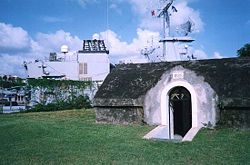Fort-de-France
|
Commune of Fort-de-France |
|
 |
|
| Fort Saint Louis | |
| Location | |
| Location of the commune (in red) within Martinique | |
| Time Zone | UTC-4 |
| Administration | |
|---|---|
| Country | France |
| Region | Martinique |
| Department | Martinique (préfecture) |
| Arrondissement | Fort-de-France |
| Canton | Chief town of 10 cantons |
| Intercommunality | Communauté d'agglomération du Centre de la Martinique |
| Mayor | Serge Letchimy (since 2001) |
| Statistics | |
| Elevation | 0 m–1,070 |
| Land area¹ | 44.21 km² |
| Population² (1999 census) |
94,049 |
| - Density | 2,127/km² (1999) |
| Miscellaneous | |
| INSEE/Postal code | 97209/ 97200 |
| 1 French Land Register data, which excludes lakes, ponds, glaciers > 1 km² (0.386 sq mi or 247 acres) and river estuaries. | |
| 2 Population sans doubles comptes: residents of multiple communes (e.g., students and military personnel) only counted once. | |


Fort-de-France is the capital of France's Caribbean département d'outre-mer of Martinique. With a population of 134,727 inhabitants (1999 census) in the urban area, 94,049 of whom live in the city (commune) of Fort-de-France proper, it is also one of the major cities in the Caribbean. Exports include sugar, rum, tinned fruit, and cacao.
Contents |
Geography
Fort-de-France lies on the island's west coast at the northern entrance to the large Fort-de-France Bay, at the mouth of the Madame River. The city occupies a narrow plain between the hills and the sea but is accessible by road from all parts of the island.
History
In 1638, Jacques Duparquet, first governor of Martinique, decided to have Fort Saint Louis built to protect the city against enemy attacks. The fort was soon destroyed, and rebuilt in 1669, when Louis XIV appointed the Marquis of Baas as governor general. Under his orders and those of his successors, particularly the Count of Blénac, the fort was built with a Vauban design.
Originally named Fort-Royal, the administrative capital of Martinique was shadowed by Saint-Pierre, the oldest city in the island, which was renowned for its commercial and cultural vibrancy as "The Paris of the Caribbean". The name of Fort-Royal was changed to a short-lived "Fort-La-Republique" during the French Revolution, and finally settled as Fort-de-France sometimes in the 19th century. The old name of Fort-Royal is still used today familiarly in its Creole language form of "Foyal", with the inhabitants of the city being "Foyalais".
The city had its share of disasters, being partially destroyed by an earthquake in 1839 and in 1890 by fire. At the turn of the 20th century, however, Fort-de-France became economically important after the volcanic eruption of Mount Pelée destroyed the town of Saint-Pierre in 1902. The city, however, never lived up to the cultural reputation of the doomed city.
Until 1918, when its commercial growth began, Fort-de-France had an inadequate water supply, was partly surrounded by swamps, and was notorious for yellow fever. Now the swamps are drained to make room for extensive suburbs.
The Fort Saint-Louis in Fort-de-France is ne of the French naval bases of the Caribbean, along with Degrad des Cannes (French Guiana).
It is under command of the capitaine de vaisseau in charge of the Navy and the Naval air force for the Caribbean (COMAR ANTILLES). The forces based here include:
- the BATRAL Francis Garnier (L9031)
- the P400 class patrol vessel Fougueuse (P685)
- the frigate Ventôse (F733)
Also here are the administrative buildings of the base, the service for naval constructions, the radio station of Pointe des Sables and the ammunition storage facilities (at the end of Fort de France), and the Rivière Salée station (20 km away).
The fort is also home to the last iguana (Iguana Delicatissima) populations of Martinique. However it is discussed whether the reptiles are native to Martinique or are remnants of the population of a small zoo that was located in the fort at the beginning of the 20th century.
Sights
The city has a fine natural harbour defended by three forts:
- Fort Desaix: built from 1763 to 1789, it was called Fort Bourbon in 1793, Fort la Convention in 1793, Fort George during the British occupations (1793-1802, 1809-1814), and Fort Desaix since 1802. This name was given by Napoleon Bonaparte after General Desaix (1768-1800).
- Fort Tartenson
- Fort Gerbault
Other sites of interest include :
- Place de la Savane
- Schoelcher Library
- Balata Garden
- Sacré-Cœur de Balata Church, a replica of the parisian Montmartre Church lodged on a cliff surrounded by tropical forest
- Fort-de-France Cathedral:[1]
A statue commemorating Martinique-born Empress Josephine, the wife of Napoleon, is in the gardens of La Savane. It was vandalized in the 1990s, presumably by individuals who faulted her for supporting the reestablishment of slavery on the island.
Transport
Martinique Aimé Césaire International Airport is located in a suburb outside Fort-de-France.
Sister cities
External links
|
|||||
|
|||||||||||